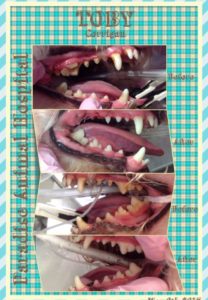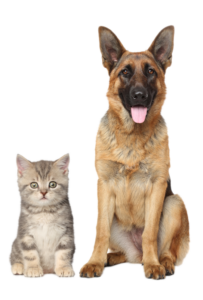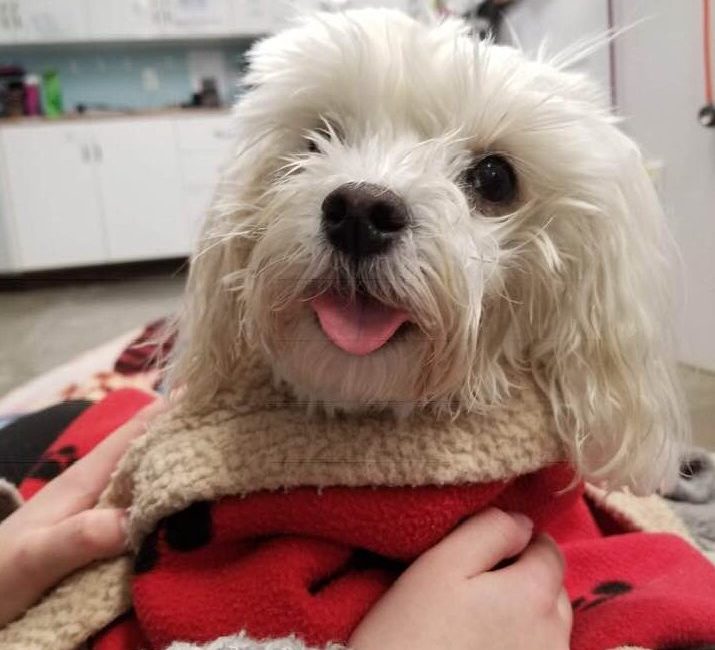Periodontal disease or dental disease, are infections of structures around the teeth. Common signs of dental disease include bad breath, red or swollen gums, tender or bleeding gums, painful chewing, difficulty eating, loose teeth, and/or receding gums. Periodontal disease affects both cats and dogs of all ages but is often seen in older animals and small breed dogs.
The first step in diagnosing/treating periodontal disease is a routine consultation by a veterinarian. The doctor performs a detailed exam of the mouth, checking all teeth. From there, the tarter/gingivitis are graded from mild-severe, and the doctor discusses all recommendations.
Tarter that is already present cannot be removed by tooth brushing; a professional dental cleaning is required under full anesthetic. Dental cleanings are done under full anesthesia mainly to ensure the patient is not in any pain/discomfort. It is also impossible to thoroughly remove plaque/tarter from the gum line if the patient is awake. Therefore causing the risk if the bacteria to seep into the root of the tooth and cause more problems/health risks for your pet.
With every dental cleaning, there is always the possibility of extractions being performed. Majority of the time extractions cannot be predicted during the examination of an animals mouth. Once an animal is anesthetized and the cleaning begins, teeth can shift/become mobile, pockets can be discovered between the tooth and the gumline, cracks/fractures can be detected, and loss of bone density can be discovered from x-rays. All of which would require the tooth to be extracted. Extractions can increase the price of a dental as some teeth can take an extensive amount of time to remove, therefore increasing the amount of anesthetic used.
My Maltese Toby John has had three dental surgeries in the past seven years of his life. His first dental was when he was five years old in 2016. He cracked his P4 or carnassial tooth. Which just so happens to be the biggest tooth in the mouth (it has three roots!) and ends up being the most expensive tooth to extract. He also had his teeth cleaned at the same time. During his second dental appointment in 2017, he lost all his bottom front teeth (incisors) because they were loose — something that I never noticed before, nor did his doctor. His third dental was in December of 2018, and he lost 3 of his top front teeth (incisors) as well as a molar (which are the teeth in the very back of the mouth). Toby doesn’t like going to the vet and never appreciates having his mouth examined. As a client, having my dog’s full mouth looked at was impossible. Whenever Toby is scheduled for a dental, I know there is always the risk of extractions. Even though Toby didn’t show any signs of pain/discomfort before his dental surgeries, after he eats his food faster, less hesitant about taking treats, and more accepting of having his mouth looked at/teeth brushed.
Toby John is an older small breed dog and is pre-disposed to dental disease. To slow down the progression, myself and my parents brush his teeth daily. Toby doesn’t like having his mouth touched, so we often use Vetradent Oral Wipes. If tooth brushing is possible with your pet, that is the first choice as it is the most effective. Other products available are dental diets, water additives, sprays, and gels. I have only used water additives, wipes and brushing due to Toby’s restrictions and found success in them.
So why are healthy gums/teeth important in animals? Is a dental cleaning really necessary? Periodontal disease can be extremely painful and uncomfortable for animals. Research has shown that bacteria/inflammation from periodontal disease can be linked to other diseases in animals, such as heart disease, kidney disease, and diabetes. The bacteria finds it’s way into the animal’s bloodstream and circulates through internal organs, and creates a negative impact.
If your pet is showing any signs of periodontal disease, call your veterinarian today and discuss your options. The best place to start is with a routine examination to see if a professional cleaning is needed. A receptionist can also give recommendations on different products to use and how to use them!

Written by: Chelsea Corrigan, Veterinary Assistant




